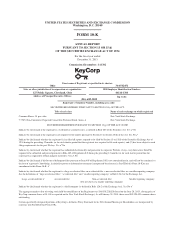KeyBank 2013 Annual Report Download - page 21
Download and view the complete annual report
Please find page 21 of the 2013 KeyBank annual report below. You can navigate through the pages in the report by either clicking on the pages listed below, or by using the keyword search tool below to find specific information within the annual report.
for national banks and federal savings associations, the FDIC for non-member state banks and savings
associations, the Federal Reserve for member state banks, the CFPB for consumer financial products or services,
the SEC and FINRA for securities broker/dealer activities, the SEC and CFTC for swaps and other derivatives,
and state insurance regulators for insurance activities. Certain specific activities, including traditional bank trust
and fiduciary activities, may be conducted in a bank without the bank being deemed a “broker” or a “dealer” in
securities for purposes of securities functional regulation. Although the states generally must regulate bank
insurance activities in a nondiscriminatory manner, the states may continue to adopt and enforce rules that
specifically regulate bank insurance activities in certain identifiable risks.
Our national bank subsidiaries and their subsidiaries are subject to regulation, supervision and examination by
the OCC. At December 31, 2013, we operated one full-service, FDIC-insured national bank subsidiary,
KeyBank, and two national bank subsidiaries that are limited to fiduciary activities. The FDIC also has certain
regulatory, supervisory and examination authority over KeyBank and KeyCorp under the FDIA and the Dodd-
Frank Act.
We have other financial services subsidiaries that are subject to regulation, supervision and examination by the
Federal Reserve, as well as other applicable state and federal regulatory agencies and self-regulatory
organizations. Our securities brokerage and asset management subsidiaries are subject to supervision and
regulation by the SEC, FINRA and state securities regulators, and our insurance subsidiaries are subject to
regulation by the insurance regulatory authorities of the states in which they operate. Our other nonbank
subsidiaries are subject to laws and regulations of both the federal government and the various states in which
they are authorized to do business.
Regulatory capital and liquidity
Current regulatory capital requirements
Federal banking regulators have promulgated risk-based capital and leverage ratio requirements applicable to
Key and KeyBank. The adequacy of regulatory capital is assessed periodically by federal banking agencies in
their examination and supervision processes, and in the evaluation of applications in connection with certain
expansion activities.
The current minimum risk-based capital requirements adopted by federal banking regulators are based on a 1988
international accord (“Basel I”) developed by the Basel Committee on Banking Supervision (the “Basel
Committee”). Under current requirements, Key and KeyBank generally must maintain a minimum ratio of total
capital to risk-weighted assets of 8%. At least half of the total capital must be “Tier 1 capital,” comprised of
qualifying perpetual preferred stock, common shareholders’ equity (excluding AOCI other than the cumulative
effect of foreign currency translation), a limited amount of qualifying trust preferred securities, and certain
mandatorily convertible preferred securities. The remainder may consist of “Tier 2 capital,” including qualifying
subordinated debt, certain hybrid capital instruments, perpetual debt, mandatory convertible debt instruments,
qualifying perpetual preferred stock, and a limited amount of the allowance for credit losses.
BHCs and banks with securities and commodities trading activities exceeding specified levels are required to
maintain capital to cover their market risk exposure in accordance with regulations adopted by federal banking
regulators. Market risk includes changes in the market value of trading account, foreign exchange and
commodity positions, whether resulting from broad market movements (such as movements in interest rates,
equity prices, foreign exchange rates, or commodity prices) or from position specific factors (such as
idiosyncratic variation, event risk, and default risk). Because Key and KeyBank each have trading assets and
liabilities of at least $1 billion or 10% of total assets, Key is subject to the Federal Reserve’s rule and KeyBank is
subject to the OCC’s rule on market risk regulatory capital, which became effective in January 2013. In
December 2013, the Federal Reserve revised, effective April 1, 2014 (or earlier if a BHC elects to adopt it
earlier), its market risk capital rule relating to the treatment of certain securitization, sovereign, and investment
company exposures as well as the timing of disclosures to align the rule to the Regulatory Capital Rules
8
























